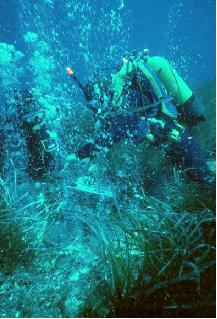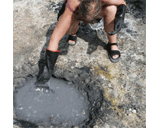
 The photograph to the left shows Dr. Jan Amend sampling at one of the off-shore vents in Sicily. The photograph to the right shows the graduate student Elisabeth Svensson sampling at one of the beach hydrothermal sites on the island of Vulcano.
The photograph to the left shows Dr. Jan Amend sampling at one of the off-shore vents in Sicily. The photograph to the right shows the graduate student Elisabeth Svensson sampling at one of the beach hydrothermal sites on the island of Vulcano.
This research is a collaboration with Dr. Jan Amend at Washington University. We work in a system of shallow vents on the island of Vulcano, close to Sicily, Italy. There are many hydrothermal vent systems in the world and many of them are in the deep ocean, on ridges between the continental plates. The system in Vulcano is practical because the vents are easy to reach – sampling can be carried out from the beach or by SCUBA diving.
Extreme environments
Hydrothermal vents are extreme environments, which in this case means they have high temperatures and unusual chemical conditions. As you might know, we can kill bacteria by increasing the temperature or by using harsh chemicals. The fact that most bacteria die in high temperatures is commonly used in sterilizing laboratory equipment by autoclaving. Even though the temperatures are high in the vents in Siciliy we know that bacteria live there, and that the types of bacteria are unusual.
Energy in extreme environments
Bacteria derive energy for living from inorganic and organic compounds. The amount of energy that can be derived from a specific reaction depends on compound concentrations, temperature and pressure. The amount of energy that can be derived from glucose under different chemical and physical conditions can be calculated by using thermodynamic equations.
Our research project is focused on determining the concentrations of some organic compounds that are known to be biologically labile, determine the chemical and physical conditions in the hydrothermal vents, and calculate the energy that bacteria could derive from the uptake of the organic compounds under the conditions of the hydrothermal vents. The theoretical energy calculations can then be compared with what the bacteria actually use for energy. In a later stage of the research we hope to be able to carry out actual uptake experiments with the bacteria to determine the compounds they prefer.
This research is supported by the National Science Foundation.
Related publications
2003, Skoog A., Vlahos P., Amend J. Concentration and distribution of dissolved neutral aldoses in a shallow hydrothermal vent system of Vulcano, Italy. Submitted to Marine Chemistry.
2003, Svensson E., Skoog A., Amend J. Concentration and distribution of dissolved amino acids in a shallow hydrothermal vent system of Vulcano, Italy. Submitted to Organic Geochemistry.